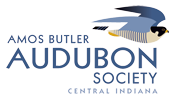ABAS: How and why did you get into bird photography?
Ryan: I got my first digital camera, the original Canon Digital Rebel, in the fall of 2003, and casually photographed birds I would see at the park starting in 2004. In the spring of 2005, I took a class at the University of Indianapolis that had a focus on Indiana Ecology. The professor, Dr. Roger Sweets, is an avid birder and that really piqued my interest in birding. From there, my new-found birding hobby and photography hobbies melded into my new bird photography obsession!
ABAS: Is there a specific species that sparked your interest in photography?
Ryan: Not really. Because I had a general interest in photography and started birding without necessarily photographing the birds, I had a general interest in birds.
ABAS: April brings the first big movements of spring migration. What is your favorite aspect of taking photographs during spring migration? What tips do you have?
Ryan: Spring migration is one of my favorite times of year to photograph birds in Indiana. The songbirds are coming through in their most pristine plumages with various shades of blues, reds, yellows, oranges, and more! One of the more difficult parts of photographing migrant warblers is so many of them will stay high in the treetops feeding on insects warming in the morning sun. The weather can often be quite finicky and that can present its own challenges, but I’ve often found that some of the best days for photographing spring migrants are those days where it is colder, rainy, or even both. The birds will often come down lower in the trees, or may even feed at eye level, gleaning small insects from the tree trunks.
I would recommend that bird photographers spend some time learning about the birds they are photographing. While bird photography can certainly be enjoyed even if the photographer doesn’t know the name of any bird they photograph, learning the birds they photograph and their habits can very much improve their experience in the field. Looking for a bird like a Cerulean Warbler in a low shrub out in the open will usually end in disappointment because they are typically found very high in the canopy. Likewise, searching for a Lincoln’s Sparrow high in a Sycamore tree is likely to be a fruitless effort.
The “next level” tip for bird photographers is to learn the vocalizations of the birds they are photographing. It’s hard to look everywhere while you’re out photographing birds, but our hearing is not typically so limited. Once the vocalizations of various species can be identified, then finding them becomes a far easier endeavor. For example, Ovenbirds are one of the more difficult warblers to see, however they are one of the most vocal warblers out there. Once an individual recognizes the familiar “TEA-cher TEA-cher TEA-cher” exploding from the undergrowth, pinpointing the location of the Ovenbird becomes much easier.
I have found the “Birding by Ear” and the companion “More Birding by Ear” [Peterson Guides] audio files (CDs when I learned them!) to be one of the best resources to listen to in your car. The narration is great and provides many tips and tricks to learn the local birds.
ABAS: What was the most impactful tip you have learned about bird photography?
Ryan: The more you learn about the birds you’re photographing, the more likely you are to get an outstanding photo of them. Learning what they will do and when they’re likely to do it is paramount in encountering the birds.
ABAS: What photograph are you the proudest of, and why?
Ryan: While perhaps not my single best photo ever, many readers own a copy of this photo of a Black-legged Kittiwake. It is the cover photo for Amar Ayyash’s recent book “The Gull Guide: North America.”
ABAS: What is something you wish you had known as a beginning photographer that you know now?
Ryan: Most birds are most active early in the morning. Lighting is often better first thing in the morning. Getting in the field very early, often at or before sunrise, is one of the single best things a bird photographer can do to improve their bird photos.
ABAS: If you could travel anywhere in the world to photograph birds, where would you go?
Ryan: I’d love to do a tour of the neotropics photographing various hummingbird species.
ABAS: How are you planning your next adventure as a bird photographer, and where are you off to?
Ryan: I’ve not done any international birding. With a wife and a five-year-old son, we haven’t planned any major international trips, but I will likely do at least a few pelagic trips in California this fall.
ABAS: Finally, where can we find more of your photography?
Ryan: I don’t have a dedicated website, but most of my photos can be found on eBird.
Editor’s note: You can also follow Ryan on Facebook and on his Flickr account- flickr.com/ryanjsanderson





